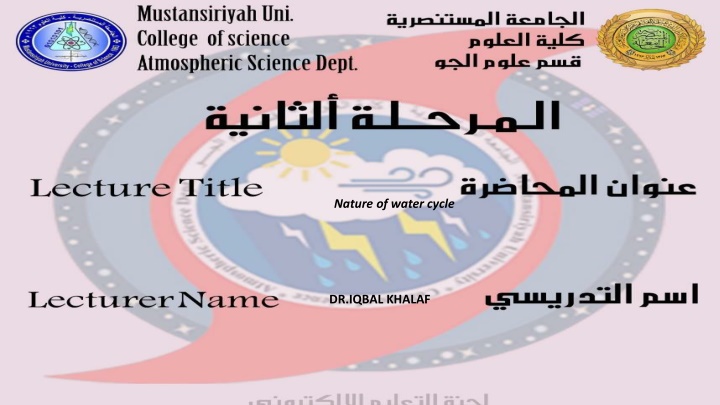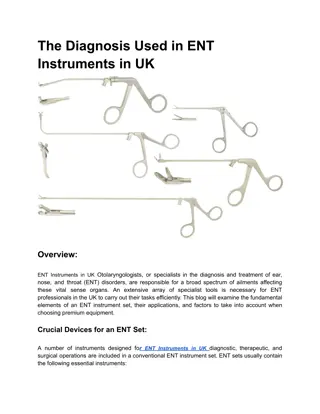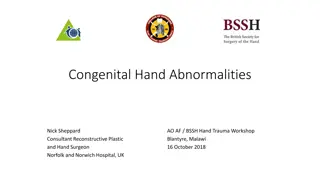ENT Signs and Syndromes in Otolaryngology
A comprehensive list of ENT signs and syndromes in otolaryngology, covering various diagnostic indicators in ear, nose, and throat conditions. Includes descriptions and visual references for common signs such as Aquino's Sign, Bocca's Sign, Browne's Sign, and more. Explore these recognizable clinical manifestations to aid in the identification and diagnosis of ENT disorders.
Download Presentation

Please find below an Image/Link to download the presentation.
The content on the website is provided AS IS for your information and personal use only. It may not be sold, licensed, or shared on other websites without obtaining consent from the author.If you encounter any issues during the download, it is possible that the publisher has removed the file from their server.
You are allowed to download the files provided on this website for personal or commercial use, subject to the condition that they are used lawfully. All files are the property of their respective owners.
The content on the website is provided AS IS for your information and personal use only. It may not be sold, licensed, or shared on other websites without obtaining consent from the author.
E N D
Presentation Transcript
Nature of water cycle DR.IQBAL KHALAF
Nature of water cycle It is the sun that moves the water cycle, where water heats up in the oceans and seas and thus causes water to evaporate in the form of water vapor in the air. The same applies to ice and ice can be directly converted to water vapor. Evaporation can occur through evaporation of water from plants that have evaporated from the soil. The H2O water vapor molecule has a density of less than the density of the main components of the atmosphere, which are both nitrogen, oxygen, N2 and O2 The main reason that water vapor molecules have less density than the main components of the atmosphere is due to the large difference in molecular mass, so water vapor in the form of gas is high in the open air as a result of buoyancy forces. However, the higher the altitude, the lower the air pressure and the lower the temperature. How to form clouds in the atmosphere: - The low temperature causes the water vapor to condense into small liquid water droplets that are heavier than air, so that they fall unless supported by the rising current. A huge concentration of these droplets over a large area of the atmosphere becomes visible as a cloud.
How the fog forms Fog is formed if water vapor condenses near ground level, as a result of wet air and cold air collisions or a sudden drop in air pressure In general, air currents move water vapor around the world, and particles within the cloud collide, grow, and fall from the upper atmosphere layers in the form of precipitation. Some precipitation falls in the form of snow or cold, and that snow, can accumulate as ice caps and glaciers, which can store frozen water for thousands of years. Most of the water falls back into the oceans or on land as rain, where water flows over the earth as a surface flow. Part of the runoff enters rivers into the valleys and as the water stream flows, water moves towards the oceans. Groundwater:- consists of the storage of runoff water and water out of the ground such as fresh water in lakes. Not all runoff flows into rivers, and many seep into the ground as infiltration. Some water seeps deep into the earth and regenerates aquifers, which can store fresh water for long periods of time. Some of the groundwater penetrates and stays close to the earth's surface and can seep back into surface water bodies (and oceans) as groundwater discharges.
Some groundwater finds openings in the surface of the earth and emerges as freshwater springs. In river valleys and river basins, there is often a constant exchange of water between surface and groundwater in the area over time, as water returns to the ocean, continuing the water cycle.
Elements of water cycle Elements of water cycle There are many different processes that lead to movements and changes in the role of water, including: 1-Precipitation It is known as condensed water vapor that falls on the surface of the earth. Most of the rainfall is in the form of rain, and sometimes also includes snow, cold and fog. Approximately 505,000 km3(121,000 cu mi) of water falls as precipitation each year, 398,000 km3 (95,000 cu mi) of it over the oceans. The rain on land contains 107,000 km3(26,000 cu mi) of water per year and a snowing only 1,000 km3(240 cu mi). 78% of global precipitation occurs over the ocean. 2-Canopy interception It is precipitation that is intercepted by plant foliage that eventually evaporates back into the atmosphere rather than falling to the ground. 3-Snowmelt The runoff produced by melting snow.
4-Runoff Are a variety of ways that water moves across the earth. This includes both runoff and run-off. In this case, a portion of the water flows and seeps into the ground, evaporates into the air, is stored in lakes or reservoirs, or is extracted for agricultural or other human uses. 5-Infiltration It is known as the flow of water from the earth's surface to the earth. Once penetrated, the water becomes moisture for soil or groundwater. However, a recent global study using stable water isotopes showed that not all soil moisture is available in all lands and at the same level to replenish groundwater or plant erosion. 6-Subsurface flow Groundwater flow, in the groundwater area. Groundwater may return to the surface or eventually seep into the oceans. Water returns to the Earth's surface at a lower altitude than at the place where it has crept, under gravitational force or gravitational pressures. Groundwater tends to move slowly and is slowly replenished, so that it can remain in aquifers for thousands of years.























